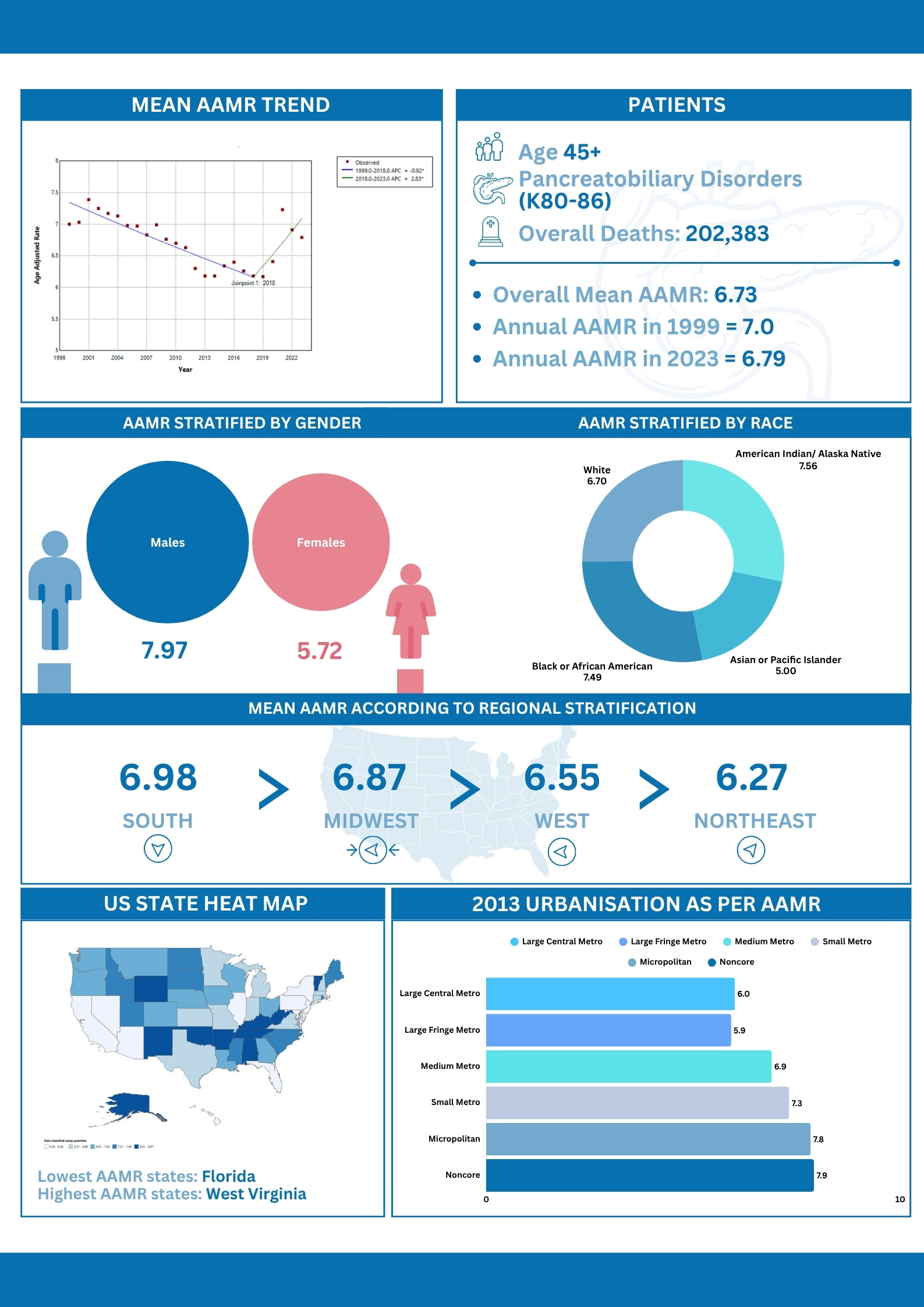Tuesday Poster Session
Category: Biliary/Pancreas
P4281 - Resurgence of Mortality Trends From Pancreatobiliary Disorders in the US Population: Insight From the CDC WONDER Database (1999-2023)
Tuesday, October 28, 2025
10:30 AM - 4:00 PM PDT
Location: Exhibit Hall

Muhammad Waqas Afzal, MBBS, MD
Sheikh Zayed Hospital, Rahim Yar Khan, Pakistan
Multan, Punjab, Pakistan
Presenting Author(s)
Farah Shehryar, MBBS1, Anfal Hamza, MBBS2, Muhammad Umair Choudhary, MBBS2, Inshal Uddin Khattak, MBBS3, Yukthi Mudiam, MBBS4, Muhammad Waqas Afzal, MBBS, MD5, Arbaz Hassan, MBBS2, Alisha Raza Qureshi, MBBS6, Afrah Najeeb, MBBS7, Talha Sajjad, MBBS, MD2, Hamza Amjad, MBBS8
1Khyber Medical College, Peshawar, Pakistan, Peshawar, Sindh, Pakistan; 2Sheikh Zayed Medical College, Rahim Yar Khan, Pakistan, Rahim Yar Khan, Punjab, Pakistan; 3Khyber Medical College, Peshawar, Pakistan, Peshawar, North-West Frontier, Pakistan; 4Apollo Institute of Medical Sciences and Research, Hyderabad, Telangana, India, Hyderabad, Telangana, India; 5Sheikh Zayed Hospital, Rahim Yar Khan, Pakistan, Multan, Punjab, Pakistan; 6Multan Medical and Dental College, Multan, Pakistan, Multan, Punjab, Pakistan; 7King Edward Medical University, Lahore, Pakistan, Lahore, Punjab, Pakistan; 8Shiekh Zayed Medical College, Rahim Yar Khan, Pakistan, Rahim Yar Khan, Punjab, Pakistan
Introduction: Although healthcare has improved over the years, literature data indicate that deaths from pancreatobiliary disorders remain consistently high. Despite this burden, national-level trends over an extended period remain underexplored. This study aims to analyze long-term mortality patterns associated with pancreatobiliary disorders among adults in the United States from 1999 to 2023.
Methods: We retrospectively evaluated pancreatobiliary disorders-related mortality data (ICD-10 Codes: K80-86) from the CDC WONDER database for individuals aged ≥ 45 in the United States from 1999 to 2023. Age-adjusted mortality rates (AAMR) per 100,000 people were extracted and stratified by year, sex, race/ethnicity, Hispanic/non-Hispanic origin, 2013 urbanization classification, and census region. Annual Percentage Changes (APC) with 95% confidence intervals (CIs) were calculated using the Joinpoint Regression Program, with statistical significance set at p < 0.05.
Results: A total of 202,383 deaths related to pancreatobiliary disorders occurred from 1999 to 2023, with an overall AAMR of 6.73 per 100,000 population. From 1999 to 2018, the AAMR declined with an APC of -0.92 (95% CI: -1.21 to -0.68; p < 0.000001), followed by a sharp rise by 2023 (APC: 2.83; 95% CI: 1.33 to 5.50; p =0.0008). Males had a higher AAMR (7.97) than females (5.72). Among racial groups, Asians or Pacific Islanders showed a consistent decline (APC: -1.10; 95% CI: -1.65 to -0.40; p =0.002000). Blacks or African Americans experienced a significant increase in AAMR from 2018 to 2023 (APC: 4.37; 95% CI: 0.75 to 12.95; p =0.019996). Similarly, Whites showed a rising trend during the same period (APC: 3.03; 95% CI: 1.29 to 6.95; p =0.001200). CENS-R1: Northeast (2018-2023) and CENS-R2: Midwest (2017-2023) showed upward trends with APCs 3.97 (95% CI: 2.42 to 6.51; p < 0.000001) and 2.58 (95% CI: 0.85 to 7.20; p =0.000400), respectively. Large Central Metro counties showed a stable decline from 2001 to 2023 (APC: -1.37; 95% CI: -1.79 to -1.22; p =0.001200). The non-Hispanic population exhibited higher AAMR than the Hispanic population (6.75 versus 6.57).
Discussion: Despite initial declines, mortality from pancreatobiliary disorders in the United States has increased significantly since 2018, with notable disparities across demographic and regional groups. Targeted prevention and equitable access to care are essential to stem the recent upsurge in pancreatobiliary-related mortality.

Figure: Graphical illustration: Resurgence of Mortality trends from Pancreatobiliary Disorders in the U.S. Population: Insight from the CDC WONDER Database (1999–2023)
Disclosures:
Farah Shehryar indicated no relevant financial relationships.
Anfal Hamza indicated no relevant financial relationships.
Muhammad Umair Choudhary indicated no relevant financial relationships.
Inshal Uddin Khattak indicated no relevant financial relationships.
Yukthi Mudiam indicated no relevant financial relationships.
Muhammad Waqas Afzal indicated no relevant financial relationships.
Arbaz Hassan indicated no relevant financial relationships.
Alisha Raza Qureshi indicated no relevant financial relationships.
Afrah Najeeb indicated no relevant financial relationships.
Talha Sajjad indicated no relevant financial relationships.
Hamza Amjad indicated no relevant financial relationships.
Farah Shehryar, MBBS1, Anfal Hamza, MBBS2, Muhammad Umair Choudhary, MBBS2, Inshal Uddin Khattak, MBBS3, Yukthi Mudiam, MBBS4, Muhammad Waqas Afzal, MBBS, MD5, Arbaz Hassan, MBBS2, Alisha Raza Qureshi, MBBS6, Afrah Najeeb, MBBS7, Talha Sajjad, MBBS, MD2, Hamza Amjad, MBBS8. P4281 - Resurgence of Mortality Trends From Pancreatobiliary Disorders in the US Population: Insight From the CDC WONDER Database (1999-2023), ACG 2025 Annual Scientific Meeting Abstracts. Phoenix, AZ: American College of Gastroenterology.
1Khyber Medical College, Peshawar, Pakistan, Peshawar, Sindh, Pakistan; 2Sheikh Zayed Medical College, Rahim Yar Khan, Pakistan, Rahim Yar Khan, Punjab, Pakistan; 3Khyber Medical College, Peshawar, Pakistan, Peshawar, North-West Frontier, Pakistan; 4Apollo Institute of Medical Sciences and Research, Hyderabad, Telangana, India, Hyderabad, Telangana, India; 5Sheikh Zayed Hospital, Rahim Yar Khan, Pakistan, Multan, Punjab, Pakistan; 6Multan Medical and Dental College, Multan, Pakistan, Multan, Punjab, Pakistan; 7King Edward Medical University, Lahore, Pakistan, Lahore, Punjab, Pakistan; 8Shiekh Zayed Medical College, Rahim Yar Khan, Pakistan, Rahim Yar Khan, Punjab, Pakistan
Introduction: Although healthcare has improved over the years, literature data indicate that deaths from pancreatobiliary disorders remain consistently high. Despite this burden, national-level trends over an extended period remain underexplored. This study aims to analyze long-term mortality patterns associated with pancreatobiliary disorders among adults in the United States from 1999 to 2023.
Methods: We retrospectively evaluated pancreatobiliary disorders-related mortality data (ICD-10 Codes: K80-86) from the CDC WONDER database for individuals aged ≥ 45 in the United States from 1999 to 2023. Age-adjusted mortality rates (AAMR) per 100,000 people were extracted and stratified by year, sex, race/ethnicity, Hispanic/non-Hispanic origin, 2013 urbanization classification, and census region. Annual Percentage Changes (APC) with 95% confidence intervals (CIs) were calculated using the Joinpoint Regression Program, with statistical significance set at p < 0.05.
Results: A total of 202,383 deaths related to pancreatobiliary disorders occurred from 1999 to 2023, with an overall AAMR of 6.73 per 100,000 population. From 1999 to 2018, the AAMR declined with an APC of -0.92 (95% CI: -1.21 to -0.68; p < 0.000001), followed by a sharp rise by 2023 (APC: 2.83; 95% CI: 1.33 to 5.50; p =0.0008). Males had a higher AAMR (7.97) than females (5.72). Among racial groups, Asians or Pacific Islanders showed a consistent decline (APC: -1.10; 95% CI: -1.65 to -0.40; p =0.002000). Blacks or African Americans experienced a significant increase in AAMR from 2018 to 2023 (APC: 4.37; 95% CI: 0.75 to 12.95; p =0.019996). Similarly, Whites showed a rising trend during the same period (APC: 3.03; 95% CI: 1.29 to 6.95; p =0.001200). CENS-R1: Northeast (2018-2023) and CENS-R2: Midwest (2017-2023) showed upward trends with APCs 3.97 (95% CI: 2.42 to 6.51; p < 0.000001) and 2.58 (95% CI: 0.85 to 7.20; p =0.000400), respectively. Large Central Metro counties showed a stable decline from 2001 to 2023 (APC: -1.37; 95% CI: -1.79 to -1.22; p =0.001200). The non-Hispanic population exhibited higher AAMR than the Hispanic population (6.75 versus 6.57).
Discussion: Despite initial declines, mortality from pancreatobiliary disorders in the United States has increased significantly since 2018, with notable disparities across demographic and regional groups. Targeted prevention and equitable access to care are essential to stem the recent upsurge in pancreatobiliary-related mortality.

Figure: Graphical illustration: Resurgence of Mortality trends from Pancreatobiliary Disorders in the U.S. Population: Insight from the CDC WONDER Database (1999–2023)
Disclosures:
Farah Shehryar indicated no relevant financial relationships.
Anfal Hamza indicated no relevant financial relationships.
Muhammad Umair Choudhary indicated no relevant financial relationships.
Inshal Uddin Khattak indicated no relevant financial relationships.
Yukthi Mudiam indicated no relevant financial relationships.
Muhammad Waqas Afzal indicated no relevant financial relationships.
Arbaz Hassan indicated no relevant financial relationships.
Alisha Raza Qureshi indicated no relevant financial relationships.
Afrah Najeeb indicated no relevant financial relationships.
Talha Sajjad indicated no relevant financial relationships.
Hamza Amjad indicated no relevant financial relationships.
Farah Shehryar, MBBS1, Anfal Hamza, MBBS2, Muhammad Umair Choudhary, MBBS2, Inshal Uddin Khattak, MBBS3, Yukthi Mudiam, MBBS4, Muhammad Waqas Afzal, MBBS, MD5, Arbaz Hassan, MBBS2, Alisha Raza Qureshi, MBBS6, Afrah Najeeb, MBBS7, Talha Sajjad, MBBS, MD2, Hamza Amjad, MBBS8. P4281 - Resurgence of Mortality Trends From Pancreatobiliary Disorders in the US Population: Insight From the CDC WONDER Database (1999-2023), ACG 2025 Annual Scientific Meeting Abstracts. Phoenix, AZ: American College of Gastroenterology.
